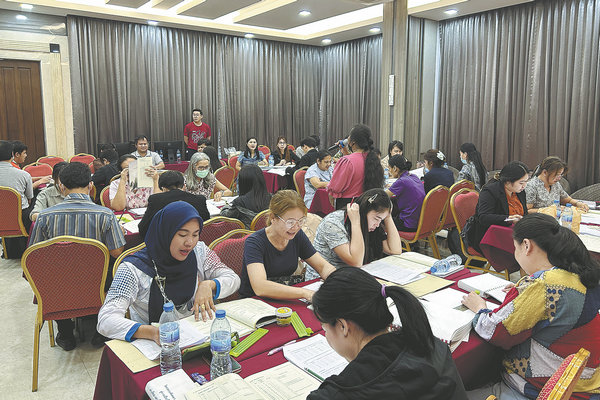

In a room at the Thailand Association of the Blind, a 30-year-old teacher with impaired vision sang the Chinese classic, The Moon Represents My Heart.
Nantaporn Gonram, who was born blind, has been fascinated by Chinese songs since childhood and started learning the language in high school.
"At first, I appreciated the sound of Chinese," the instructor says."Then, I gradually learned about the profoundness of Chinese culture."
Nantaporn became the first visually impaired graduate of the School of Sinology of Mae Fah Luang University in 2022 and participated in the first Thai Chinese Braille textbook training last year.
Braille, also known as embossed characters, is a type of character specially designed for visually challenged people that relies on tactile perception. The six-dot system is a universal method used by the world, which expresses meanings through different arrangements of the six dots.
Tevapong Puangpetch, chairman of the Thai National Braille Promotion and Development Fund, showed the Chinese Braille textbooks that were published recently.
The fund is affiliated with the Thailand Association of the Blind. There are currently 17 schools for those with impaired vision in Thailand. With the economic and cultural exchanges deepening between China and Thailand in recent years, more and more such schools have begun to offer Chinese courses, and the demand for Chinese Braille textbooks has become increasingly urgent, says Tevapong.
"If visually impaired students want to learn Chinese well, in addition to listening and speaking skills, reading and writing are also important," says Tevapong.
He adds that the Chinese teaching at Mae Fah Luang University is excellent, and they have the experience of teaching visually impaired students.
Last year, the Thailand Association of the Blind collaborated with teachers from the School of Sinology of Mae Fah Luang University to compile Chinese Braille textbooks, aiming to help visually impaired students learn Chinese reading and writing more conveniently and efficiently.
Noppakao Saekhow, a lecturer from the School of Sinology, is one of the authors of Chinese Braille textbooks.
Noppakao says the Thai school previously lacked systematic and comprehensive Chinese Braille textbooks. The purpose of compiling this textbook is to target visually impaired students and teachers in Thailand to teach Chinese learners at different stages.
After two months of compilation and revision, the Chinese Braille textbooks were completed in the middle of last year, and the first 300 copies were printed with funding by the Bank of China (Thailand) for training teachers in Thai schools for the visually impaired.
"Before the publication of Chinese Braille textbooks in Thailand, people usually used English Braille to notate Chinese characters, but the pronunciation was often not standard," says Nantaporn.
She adds that the new textbooks not only use the pinyin Braille system to make the pronunciation more accurate but also add Chinese tones and provide Chinese and Thai Braille comparisons, which is much more convenient than when she learned Chinese before.
This year, the association plans to print another 200 textbooks and promote them to many schools in Thailand for visually impaired students, says Tevapong.